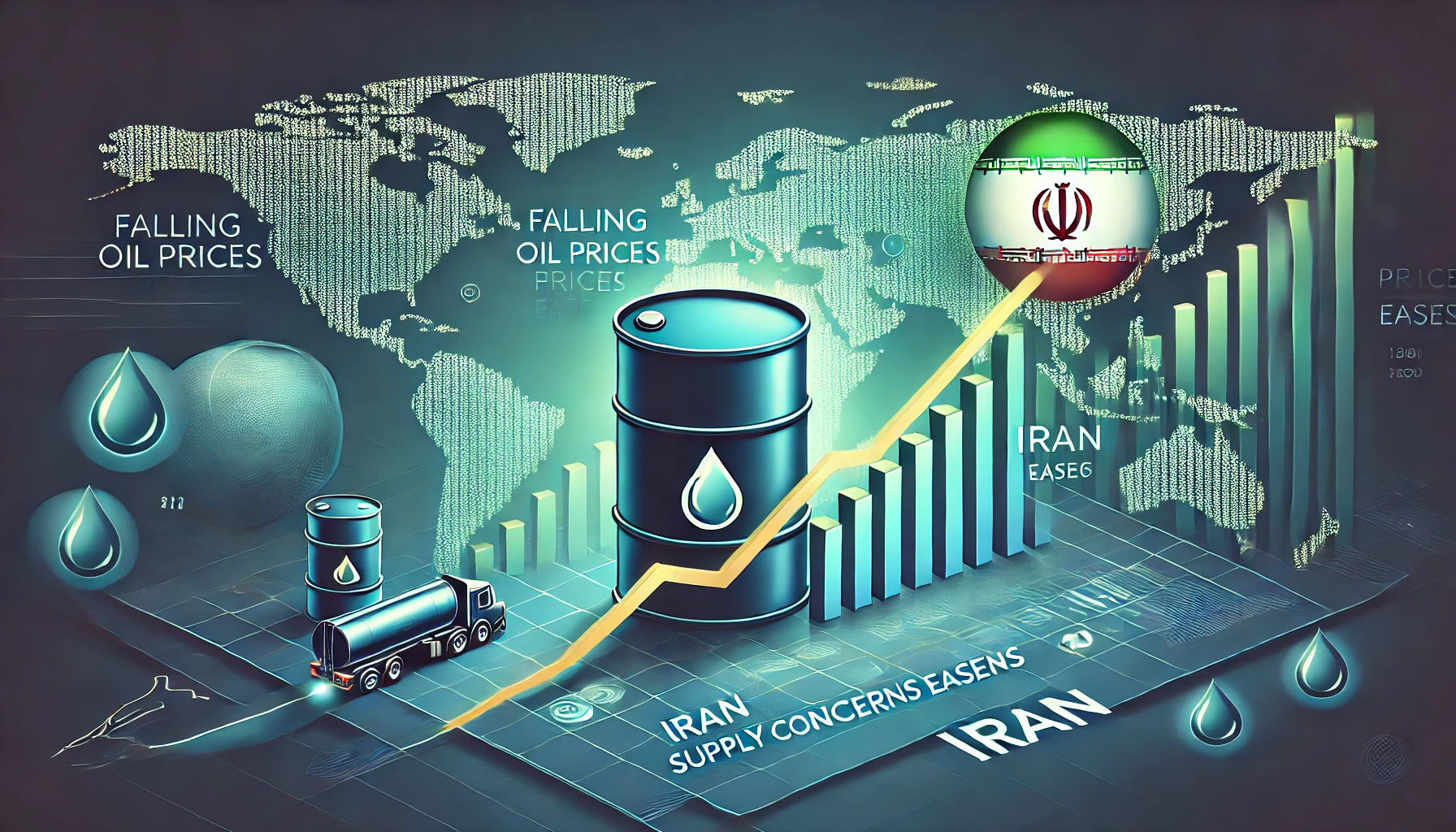Oil Falls as Demand Outlook Weakens, Iran Supply Disruption Concerns Ease
The global oil market is once again in flux as oil prices experience a decline due to a combination of factors. A weakening demand outlook, particularly in key regions like Europe and Asia, and the easing of concerns over Iran oil supply disruptions have significantly impacted both crude oil prices and the broader oil market outlook. As these events unfold, industry analysts and investors are closely monitoring the situation to understand how it will shape oil price forecasts and the future of energy markets.
In this blog, we will explore the primary factors driving the recent drop in oil prices, including the weakening global oil demand and the stabilization of Iran oil exports. We’ll also delve into how the easing of Iran oil sanctions is influencing the global supply chain and assess the potential long-term impacts on the oil market outlook.
Global Oil Prices Decline Amid Weakening Demand
The decline in oil prices has been driven largely by a deteriorating demand outlook. As global economic growth slows, particularly in Europe and Asia, the demand for oil has weakened. This reduction in demand comes at a time when many economies are grappling with inflation, higher interest rates, and slower industrial output. As a result, both crude oil prices and the overall energy market have been affected.
The Role of Global Oil Demand in Price Fluctuations
Global oil demand is one of the primary factors influencing oil price forecasts. When demand is strong, prices tend to rise as suppliers struggle to meet the needs of consumers. Conversely, when demand weakens, as it has in recent months, prices fall as oil producers cut back production or risk oversupply. The International Energy Agency (IEA) recently reported that global demand for oil is expected to drop as industrial activity in key markets, such as China and the European Union, continues to slow.
The weaker demand is particularly pronounced in sectors like transportation and manufacturing, both of which are major consumers of oil. As industries face reduced output and declining consumer demand for goods, the need for fuel decreases, resulting in a downturn in global oil consumption. This trend is reflected in the weakening oil market outlook, with analysts adjusting their forecasts downward to account for lower-than-expected demand.
Economic Factors Contributing to Weak Oil Demand
Several economic factors are contributing to the weakening global oil demand:
- Slower economic growth: Major economies like China, the European Union, and the United States are all experiencing slower growth, leading to reduced industrial activity and energy consumption.
- Inflation and higher interest rates: Central banks worldwide have raised interest rates to combat inflation. Higher borrowing costs have curtailed business investments and consumer spending, further reducing demand for energy.
- Energy transition: As countries invest in renewable energy and electric vehicles, the global dependence on oil is gradually decreasing. This long-term trend is expected to continue affecting demand in the coming years.
Given these dynamics, it’s clear that the current oil price forecast reflects not only short-term fluctuations but also longer-term economic trends that will continue to impact the global energy landscape.
Easing Concerns Over Iran Oil Supply Disruptions
In addition to weakening demand, the easing of concerns over Iran oil supply disruptions has also contributed to the decline in oil prices. For months, geopolitical tensions between Iran and Western nations have raised fears of supply interruptions that could drive prices higher. However, recent developments have led to more stability in Iran oil exports, which has alleviated concerns about major disruptions in the global oil supply chain.
The Impact of Iran Oil Supply on Global Markets
Iran oil supply plays a significant role in global energy markets. As one of the largest oil producers in the world, Iran’s ability to maintain steady exports is critical to ensuring a stable global supply. In recent years, Iran oil sanctions have limited the country’s ability to sell oil on the international market, leading to volatility in crude oil prices. However, recent talks between Iran and Western nations have led to the possibility of easing sanctions, which would allow for an increase in Iran oil exports.
With the easing of sanctions, many analysts now expect Iran to ramp up production, bringing additional barrels of oil to the market. This has helped stabilize the global supply chain, further contributing to the drop in oil prices. Although geopolitical tensions remain a concern, the immediate risk of a major supply disruption has diminished.
The Role of Sanctions in Iran’s Oil Production
Iran oil sanctions have been a key factor limiting the country’s production capacity. In recent years, these sanctions have cut Iran off from many of its traditional buyers, including European and Asian markets. However, the possibility of sanctions relief could allow Iran to re-enter these markets, significantly increasing its export capacity.
Should sanctions be lifted or eased further, it is estimated that Iran could increase its oil exports by several hundred thousand barrels per day, which would add to the global supply and exert downward pressure on prices. The prospect of greater supply stability from Iran is a key factor in the more optimistic oil market outlook for the near future.
Oil Market Outlook: What’s Next for Global Oil Prices?
The combination of weakening demand and stabilizing Iran oil supply has led to a more cautious oil market outlook for the coming months. With oil demand weakening in major markets and supply concerns easing, oil price forecasts are expected to remain lower than previous projections.
Oil Price Forecast: What to Expect in the Coming Months
According to industry experts, oil price forecasts for the rest of the year will likely depend on several factors:
- Economic Recovery: If global economic growth picks up, particularly in Asia and Europe, there could be a rebound in global oil demand. This would push prices higher as producers struggle to meet increased demand.
- Geopolitical Stability: The situation in the Middle East, including the future of Iran oil sanctions, will continue to play a major role in determining the direction of crude oil prices. Any escalation of tensions could disrupt supply and lead to price spikes.
- OPEC+ Decisions: The Organization of the Petroleum Exporting Countries (OPEC) and its allies (OPEC+) have historically played a significant role in stabilizing oil prices by adjusting production levels. Their actions in response to changes in demand and supply will be key in shaping future oil price forecasts.
- Energy Transition: As the world shifts toward renewable energy and electric vehicles, the long-term demand for oil is expected to decline. This will gradually reduce the upward pressure on oil prices, although the pace of this transition remains uncertain.
Key Takeaways for Investors and Industries
For investors and industries that rely on oil, the current oil market outlook presents both challenges and opportunities. While weaker demand and stable supply have led to lower crude oil prices, the potential for geopolitical disruptions or changes in economic conditions could still lead to volatility. Investors should remain cautious and consider the broader economic factors at play when making decisions related to energy markets.
Industries that are heavily dependent on oil, such as transportation and manufacturing, may benefit from lower oil prices in the short term, but they must also be prepared for potential price increases if demand rebounds or supply is disrupted.
A Shifting Oil Market in 2024
As oil prices fall amid a weakening demand outlook and easing concerns over Iran oil supply disruptions, the global oil market is undergoing significant changes. The factors driving the current oil market outlook are complex, with economic, geopolitical, and environmental considerations all playing a role.
For now, the combination of declining global oil demand and stabilizing Iran oil exports suggests that prices will remain relatively low in the near term. However, the longer-term outlook will depend on how quickly economies recover, the future of Iran oil sanctions, and the broader energy transition away from fossil fuels.
For those tracking oil price forecasts and the energy market’s future, it is essential to stay informed about these developments and how they may impact global supply and demand dynamics. To explore more insights on market trends and economic forecasts, visit Regent Studies.



